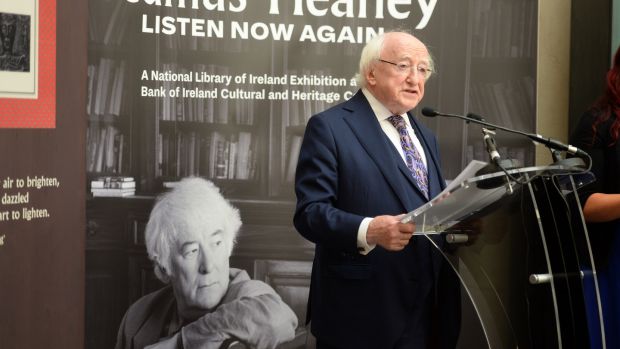
As Seamus Heaney moved into middle age, he found himself becoming public property. Along with the dubious honour of being quoted by every politician from here to the White House, Heaney found himself contending with the steady narrowing of his private life.
In an interview with Dennis O’Driscoll, Heaney commented, “you end up dropping back through your own trapdoors, with a kind of ‘they-can’t-take-this-away-from-me’ feeling”. But now, almost five years after the poet’s death, all is on show once again.
This morning President Michael D Higgins launched “Seamus Heaney: Listen Now Again” at the Cultural and Heritage Centre in Bank of Ireland on College Green. The exhibition is the first to be housed in the new space, which was opened earlier today by Josepha Madigan, the Minister for Culture, Heritage and the Gaeltacht.
Paul Shovlin, the Chairman of the National Library of Ireland, welcomed President Higgins, whom he described as “an extraordinary poet and public intellectual” in his own right. In his address, Higgins, a friend of the late poet’s, praised Heaney as a man and as an artist. He commended Heaney’s humility and his gift for friendship, as well as his deft poetic exposure of “the hidden extraordinary in the familiar”. Higgins concluded by congratulating the organisers of the exhibition for having drawn together the different strands of “the poetic genius that was Seamus Heaney”.
Marie Heaney, the late poet’s wife, spoke briefly, thanking Higgins for what she called “a truly remarkable speech”. Her husband, she said, would have been “amazed” by what’s been achieved using the material he donated to the National Library of Ireland, and she expressed in closing her hope that the exhibition would let “poetry flourish here in the heart of the city of Dublin”.
The exhibition itself, billed as an “intimate and immersive visitor experience”, is divided into four sections, each exploring a different aspect of the poet’s life and work. Excavations focuses on Heaney’s early work and home-life, and is followed by Creativity, which examines the poet’s methods of composition. Conscience and Marvels respectively examine his ethical concerns and the lighter, more ethereal public voice employed in his later work.
“Listen Now Again” features original manuscripts, letters, unpublished works, diary entries and photographs. The convergence of the personal, the poetic and the political is captured by an envelope displayed near the entrance. Sent enclosing the proofs of “Digging”, the envelope is addressed to Heaney at St Joseph’s Training College, the Catholic boys’ school at which he briefly taught – but jostling for space with his own name and address are the impresses and stamps, crowns and arms, of England, the location of his publisher.
The only elements of the exhibition that are somewhat incongruous are the contributions of Maser, a young Irish visual artist. One of these hangs from the ceiling, a circling flock of candy-striped birds, lit by a frosted skylight, in pinks and blues, yellows and reds. The other is a black wall which beams “Don’t Be Afraid” in luminous letters, inviting visitors to decorate the blank space in chalk with their comments and meditations. These contributions are inoffensive in themselves but their aesthetic spirit, especially that of the latter work, is so unlike Heaney’s own that the effect is slightly jarring.
“Listen Now Again” opens Friday, July 6th, with visitors welcome from 10am to 4pm Monday to Saturday. Entrance is free and, after the busy opening weekend, no booking will be required. Situated on the doorstep of College, and running until December 2021, Trinity students have no excuse to miss this exhibition.






